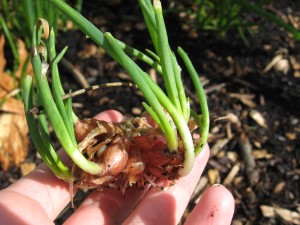The onions are a-walkin’

I frequently get questions from folks here in the Northwest who struggle to grow onions. Their sets either rot in the ground, or never produce substantially-sized bulbs before the season ends. The truth is that to get large onions (Walla Walla Sweets and others) to produce really well in a shorter, cool season is tricky. I have given up on growing them altogether (because I’m a lazy gardener). Don’t be discouraged, there are other more reliable (and I think, superior) options.
We grow leeks, shallots, garlic, and little cippolini onions with no problem here in Portland. Garlic and shallots are planted in October for a mid-summer harvest. Leeks are started from seed in August and grow overwinter for a Feb or March harvest.   Cippolinis are started from seed indoors in late winter and harvested in mid-late summer.
But there is one onion that takes zero work and left to itself in a sunny location will produce a continual harvest of green onions and zippy onion bulbs. That plant is the perennial Egyptian walking onion. Also known as tree onions, these clumping plants produce hollow, scallion like greens and a shallot-sized bulb. It is one of the first plants to come back in spring, and is rich in vitamin A.

Late in summer, they grow bulb-lets on the top of stalks, which will eventually sprout, fall over and root in the soil. You can either let them flop over on their own (i.e. “walk”) or you can eat them (I think they’re tasty raw), or you can cut them off and plant them where you will.
In the top photo you can see the parent “clump” on the right, and where I have let the bulb-lets fall last autumn, there is a new little clump on the left (directly in front of the chard).
If you’d like to try some walking onions, I’d be happy to give you a clump, or you can purchase them at various nurseries and suppliers. Simply plant your bulb-lets in a sunny, well-drained spot and be careful not to set them too deeply.
Happy gardening!